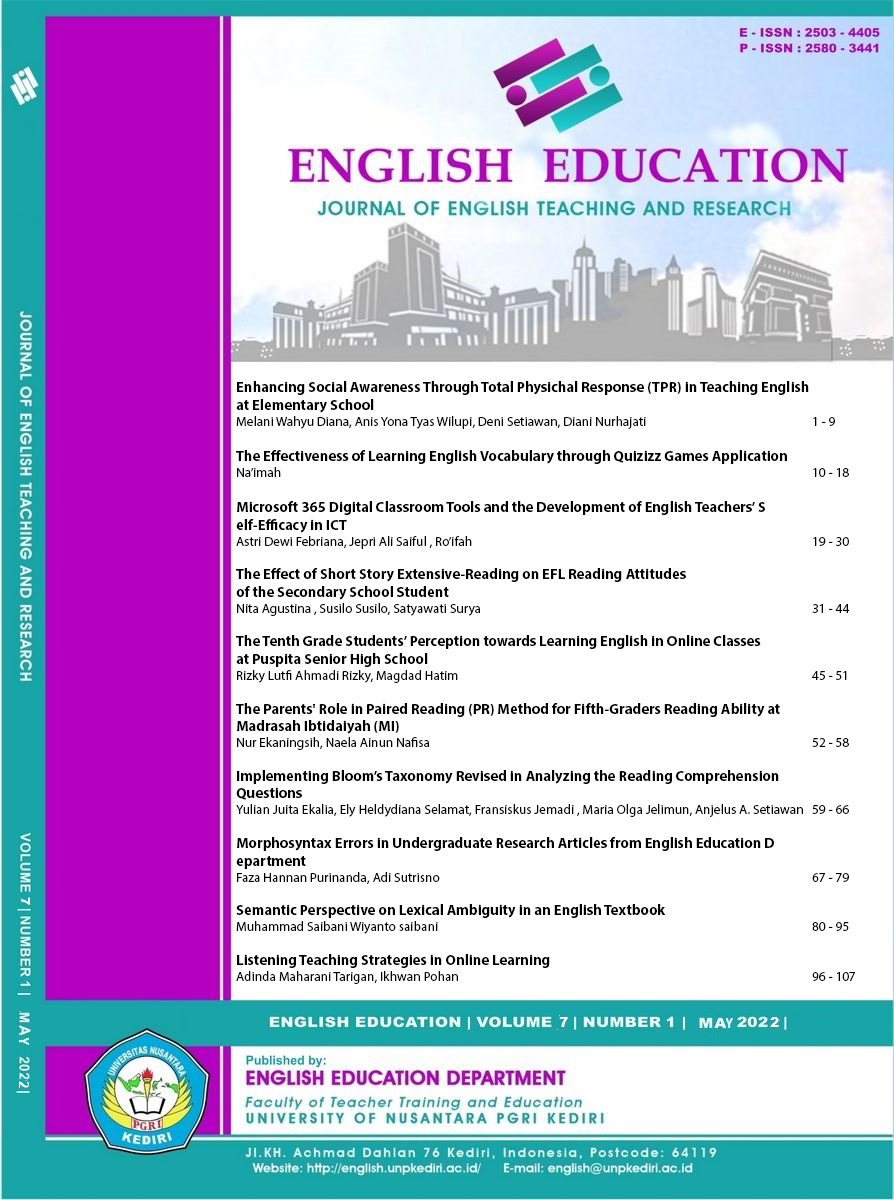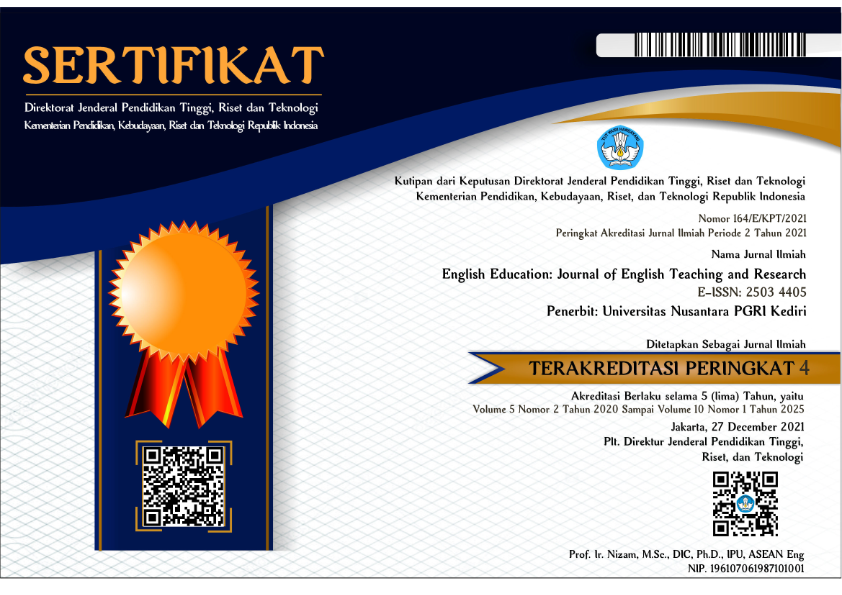The Effectiveness of Learning English Vocabulary through Quizizz Games Application
DOI:
https://doi.org/10.29407/jetar.v7i1.17733Keywords:
English vocabulary, games quizizz, learning motivationAbstract
The inspiration and innovation used to learn English are still minimal. The learning thatoccurs is to imitate, record, and maintain vocabulary. This condition makes students think learning English is troublesome. At the same time, English is considered necessary because it is an international language and is widely used. This article discusses how powerful English learning is in a fun and liked way for children, mainly through quiz games. The methodology used in this study is subjective. The researcher analyzes and collects information along with data on research topics and makes a difference to English coaches about their meetings when involving the Quizizz application as a learning medium to build student inspiration in learning English. The Quizizz game application teaching media makes students more interested in learning a language and makes teaching easy and effective. Based on the exploration directed by scientists, it is possible to reason that learning English through game applications is very powerful and ready to expand students' learning inspiration. Games are learning media that can create an exciting learning climate but do not reduce or reduce students' understanding of the material and can expand their learning inspiration in vocabulary learning. This educational game provides benefits in learning media because this media is exciting and can inspire considerable brain work and then use time productively.
Keywords: English vocabulary, games quizizz, learning motivation
Downloads
References
Aini, Y. I. (2019). Pemanfaatan Media Pembelajaran Quizizz Untuk Pembelajaran Jenjang Pendidikan Dasar Dan Menengah Di Bengkulu. Jurnal Kependidikan, 2(25), 1–6.
Amalia, D., & Husna, N. (2020). Introvert Learners’ Need Analysis of English-Speaking Activity. IJEE (Indonesian Journal of English Education), 6(2), 91–108. https://doi.org/10.15408/ijee.v5i2.10134
Anggayana, I. W. A., Budasi, I. G., & Suarnajaya, I. W. (2013). Affixation of bugbug dialect: A Descriptive Study. Jurnal Pendidikan Bahasa Inggris Undiksha, 1(1).
Dimyati, & Mudjiono. (2015). Belajar dan Pembelajaran. Jakarta : Rineka Cipta.
Faridatuunnisa, I. (2020). Kebijakan dan Pelaksanaan Pembelajaran Bahasa Inggris untuk SD di Indonesia. Prosiding Seminar Nasional, 191–199.
M. Szmigiera. (2022). The most spoken languages worldwide in 2021. Statista.
Megawati, F. (2016). Kesulitan Mahasiswa dalam Mencapai Pembelajaran Bahasa Inggris Secara Efektif. PEDAGOGIA: Jurnal Pendidikan, 5(2), 147. https://doi.org/10.21070/pedagogia.v5i2.246
Mulatsih, B. (2020). Penerapan Aplikasi Google Classroom, Google Form, dan Quizizz dalam Pembelajaran Kimia di Masa Pandemi Covid-19. Ideguru: Jurnal Karya Ilmiah Guru, 5(1), 16–26.
Peraturan Pemerintah Republik Indonesia. (2021). Peraturan Pemerintah Republik Indonesia Nomor 57 Tentang Standar Nasional Pendidikan. Standar Nasional Pendidikan, 102501, 1–49.
Permana, P., & Permatawati, I. (2020). Using Quizizz as a Formative Assessment Tool in German Classrooms. 424(Icollite 2019), 155–159. https://doi.org/10.2991/assehr.k.200325.073
Purandina, I. P. Y. (2021). Implementasi Media Digital Untuk Perkembangan Bahasa Inggris Anak Usia Dini. Pratama Widya: Jurnal Pendidikan …, 6(1).
Purwaningsih, S., Tjahjono, T., Retnaningdyah, P., & Anam, S. (2021). Assessing Students’ Ability About 16 Active Voice Tenses Using Quizizz Application. Jurnal Smart, 7(2), 58–71. https://doi.org/10.52657/js.v7i2.1494
Risan, R. (2021). Identifying the Use of Quizzes for Students During Online Learning. Jurnal JOEPALLT (Journal of English Pedagogy, Linguistics, Literature, and Teaching), 9(2), 52–63. https://doi.org/10.35194/jj.v9i2.1782
Siyoto, S., & Sodik, M. A. (2005). Dasar Metodologi Penelitian. Literasi Media Publishing.
Sophya, I. V. (2014). Desain Pembelajaran Bahasa Inggris Untuk Pendidikan Anak Usia Dini. ThufuLA: Jurnal Inovasi Pendidikan Guru Raudhatul Athfal, 2(2), 251. https://doi.org/10.21043/thufula.v2i2.4639
Susanthi, I. G. A. A. D. (2021). Kendala dalam Belajar Bahasa Inggris dan Cara Mengatasinya. Linguistic Comunity Service Journal, 1(2), 64–70.
Susanti, D. I., & Prameswari, J. Y. (2020). Adaptasi Blended Learning di Masa Pandemi COVID-19 untuk Pembelajaran Bahasa Inggris di Sekolah Dasar. Lingua Susastra, 1(2), 50–61. https://doi.org/10.24036/ls.v1i2.8
Tanjung, A. A., & Muliyani. (2021). Metodologi Penelitian Sederhana, Ringkas, Padat Dan Mudah Dipahami. SCOPINDO MEDIA PUSTAKA.
Xu, W. (2019). An Empirical Study of the Predictability of Vocabulary Knowledge and Reading Ability on Redesigned SAT Critical Reading and Implication for English Testing System in China. 3rd International Seminar on Education Innovation and Economic Management (SEIEM 2018), 251–253.
Yuhendra, Y. (2018). Analisa Pentingnya Pemahaman Lintas Budaya Dalam Kelancaran Berkomunikasi Bahasa Inggris Pada Mahasiswa Jurusan Bahasa Inggris. Jurnal KATA, 2(1), 140. https://doi.org/10.22216/jk.v2i1.2733
Downloads
Published
Issue
Section
License
Authors who publish with this journal agree to the following terms:
- Copyright on any article is retained by the author(s).
- The author grants the journal, the right of first publication with the work simultaneously licensed under a Creative Commons Attribution License that allows others to share the work with an acknowledgment of the work’s authorship and initial publication in this journal.
- Authors are able to enter into separate, additional contractual arrangements for the non-exclusive distribution of the journal’s published version of the work (e.g., post it to an institutional repository or publish it in a book), with an acknowledgment of its initial publication in this journal.
- Authors are permitted and encouraged to post their work online (e.g., in institutional repositories or on their website) prior to and during the submission process, as it can lead to productive exchanges, as well as earlier and greater citation of published work.
- The article and any associated published material is distributed under the Creative Commons Attribution-ShareAlike 4.0 International License








 Article template
Article template



